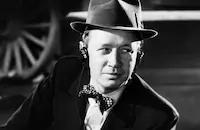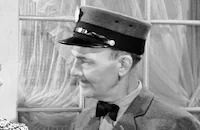The War Against Mrs. Hadley

Brief Synopsis
Cast & Crew
Harold S. Bucquet
Edward Arnold
Fay Bainter
Richard Ney
Jean Rogers
Sara Allgood
Film Details
Technical Specs

Synopsis
On December 7th, 1941, the wealthy Mrs. Stella Hadley celebrates her birthday just as she always has, surrounded by her closest family and friends: her hard-drinking son Theodore, down-to-earth daughter Patricia, flighty best friend, Cecilia Talbot, her physician, Dr. Leonard V. Meecham, and old admirer, Elliott Fulton, who has a high position in the War Department. As Elliott says, Stella lives in an "ivory tower," refusing to pay attention to world affairs or read The Chronicle , the newspaper formerly owned by her late husband. When the radio is turned on, they hear the news of the Japanese bombing of Pearl Harbor, but Stella maintains that her life should not change, just because of a war. On Christmas Eve, Stella is annoyed that Ted has to work for Elliott. When she telephones Elliott to complain, he apologizes, even though Ted has lied about working late. Elliott then decides that a tour of active duty would be good for Ted. Meanwhile, Bennett, the family butler, secretly becomes an air raid warden, and Patricia works at a servicemen's canteen where she meets soldier Michael Fitzpatrick. They are attracted to each other, but when Mike drives her home, he is concerned over Pat's obvious wealth. She convinces him that he is a snob, and the two begin to fall in love. Some time later, when Ted is drafted, Stella tries to convince Elliott to get him out of it, but he refuses, prompting her to tell him that she never wants to see him again. Though reluctant to be inducted at first, Ted finally determines to do his duty and soon is thriving in the Army. At the same time, Cecilia has secretly joined a women's First Aid group headed by Stella's rival, Laura Winters, whose husband, a strong Democrat, purchased the formerly Republican Chronicle . On a visit to Ted's army camp Stella is chagrined to find that he has become friendly with Mike, who used to work in the Chronicle 's ad department, and has also become very close to Laura's son Tony. Back at home, when Pat tells Stella that Mike is soon to be transferred to Phoenix and has proposed, Stella forbids their marriage. Trying to persuade her mother, Pat says that Elliott approves of Mike, but Stella is so angered by Pat's apparent disloyalty that she sends her away. Stella then feigns one of her "attacks" and has Bennett call Elliott's apartment to summon Pat, but Pat knows that her mother is merely faking and refuses to go to her. Some time later, Mrs. Fitzpatrick, Mike's kindly Irish-American mother, goes to see Stella and tells her that Mike and Pat will be married in the Catholic Church a few days later. Stella acts rudely and snobbishly toward Mrs. Fitzpatrick and after she leaves, goes to talk with Cecilia, thinking that she is home ill. When she finds that Cecilia is hosting a first aid class headed by Laura, Stella angrily departs, finally cutting herself off from almost everyone who cares for her. As the weeks pass, Stella hears nothing from Ted, who has been shipped to the Pacific, then finally receives a letter saying he is fine. That same day, Bennett brings in one of the newspapers, which reveals that Ted is a hero and has just been awarded the Distinguished Service Cross. Shortly thereafter, Mrs. Fitzpatrick arrives to talk about their impending grandchild. Stella is hurt not to have heard from Pat, but brightens when she receives Pat's telegram. Just then, reporters barge in asking for an interview about Ted, but Stella snobbishly refuses until one reporter says that Laura was kind enough to speak with them, even though Tony's DSC is being awarded posthumously. Now realizing how selfish she has been, Stella goes to Laura and reads her Ted's letter in which he talked about how much his friendship with Tony meant to him. Laura then tells Stella that they must all work together so that the deaths of young men like her son will not be in vain. Back at her home, Stella is touched that President Roosevelt took the time to send her a personal note, hand-delivered by Elliott. The two reconcile, and several months later, after they have married, the home is busy with war-related activities, which Stella coordinates with Laura, Cecilia and Mrs. Fitzpatrick. Finally, Mrs. Fitzpatrick has to pry Stella away from Elliott and her war work so they can both get to Phoenix before the birth of Pat's baby.

Director

Harold S. Bucquet
Cast

Edward Arnold

Fay Bainter
Richard Ney

Jean Rogers
Sara Allgood

Spring Byington

Van Johnson

Isobel Elsom

Frances Rafferty

Dorothy Morris

Halliwell Hobbes

Connie Gilchrist

Horace Mcnally

Miles Mander

"rags" Ragland
Mark Daniels

Carl Switzer

Kay Medford
William Roberts
George Offerman Jr.

Eddie Acuff
Robert Middlemass
Henry Sylvester

Addison Richards
William Tannen

Walter Sande
Frances Carson
Mary Currier
Shirley Warde
Ruby Dandridge

John Butler
Robert Emmett Keane

Roger Moore
Harry Hayden
Dick Simmons

Frank Ferguson
Mickey Rentschler
Henry Sylvester
Colin Campbell
Lowden Adams
Crew
Irving Asher
John S. Detlie
Karl Freund
Cedric Gibbons
Henry Grace
Horace Hough
Kalloch
Gil Kurland
George Oppenheimer
Al Raboch
Douglas Shearer
David Snell
Elmo Veron
Edwin B. Willis

Film Details
Technical Specs

Award Nominations
Best Writing, Screenplay
Articles
The War Against Mrs. Hadley
Fay Bainter had one of her best screen roles as Mrs. Hadley, and only an actress of Bainter's enormous talent could find nuances in such an unsympathetic character. Bainter didn't make her first film until she was 41, but she had a lifetime of theatrical experience behind her. She had made her stage debut at the age of six, and at 14 began playing ingénues in stock companies. At 20, she made her Broadway debut, and was a top leading lady for two decades. Her stage training made Bainter a natural for talkies, and she made her film debut in 1934. By that time, she was smart enough and talented enough to make the best of the character roles that would be the staple of her film career. She won a Best Supporting Actress Oscar® for Jezebel (1938), and that same year she was also nominated for Best Actress for White Banners (1938), losing to her Jezebel co-star, Bette Davis. Bainter was signed to a contract by MGM in 1940, and spent the next several years playing everyone's mother. The War Against Mrs. Hadley was one of her rare but welcome forays into leading lady territory.
Supporting Bainter's superb performance were some of the best character actors in the business. Edward Arnold, who played Mrs. Hadley's beau, also had extensive stage experience, appeared in silent films, and joined MGM in 1933. He spent 18 years at the studio. Like Bainter, he played primarily character roles, but had some impressive starring performances in Diamond Jim (1935) and Come and Get It (1936). Spring Byington, who played Mrs. Hadley's best friend, was one of Bainter's fellow MGM mothers, specializing in playing sunny but flighty matrons. She was nominated for a Best Supporting Actress Oscar® for one of them, in You Can't Take It with You (1938).
The War Against Mrs. Hadley also featured several up-and-coming younger players. Van Johnson had one of his best early roles as a young sailor who falls in love with Mrs. Hadley's daughter. It was his fourth film. Jean Rogers, who played the daughter, had almost a decade's worth of serials and B-movies behind her. Best known for playing Dale Arden in the Flash Gordon serial, she had left Universal and Fox because she wasn't getting good roles. She signed with MGM in 1941. Richard Ney, who played Mrs. Hadley's son, had just played the son in Mrs. Miniver (1942). He, too, was a relative newcomer to films.
Critics, even those who did not like The War Against Mrs. Hadley, praised Bainter's performance. The Time critic, in the magazine's typically wisecracking style, commented on the film's liberal viewpoint: "[It] is an all-out jihad to save Fay Bainter's soul for the New Deal." But he also added, "Fay Bainter succeeds against hopeless odds in making her absurd part plausible." The War Against Mrs. Hadley was nominated for an Academy Award for Best Original Screenplay, but lost to Woman of the Year (1942). The winner for Best Adapted Screenplay that year was Mrs. Miniver.
Director: Harold S. Bucquet
Producer: Irving Asher
Screenplay: George Oppenheimer
Cinematography: Karl Freund
Editor: Elmo Veron
Costume Design: Robert Kalloch
Art Direction: Cedric Gibbons
Principal Cast: Edward Arnold (Elliott Fulton), Fay Bainter (Stella Hadley), Richard Ney (Theodore Hadley), Jean Rogers (Patricia Hadley), Sara Allgood (Mrs. Fitzpatrick), Spring Byington (Cecilia Talbot), Van Johnson (Michael Fitzpatrick).
BW-86m.
by Margarita Landazuri

The War Against Mrs. Hadley
TCM Remembers Van Johnson - Important Schedule Change on TCM In Honor To Salute VAN JOHNSON
The new schedule for the evening of Tuesday, December 23rd will be:
8:00 PM In the Good Old Summertime
9:45 PM A Guy Named Joe
12:30 AM Thirty Seconds Over Tokyo
2:30 AM The Last Time I Saw Paris
4:30 AM Thrill of a Romance
Van Johnson (1916-2008)
Van Johnson, the boyish leading man whose clean cut, All-American appeal made him a top box-office draw for MGM during World War II, died on December 12 in Nyack, New York of natural causes. He was 92.
He was born Charles Van Dell Johnson on August 25, 1916, in Newport, Rhode Island. By his own account, his early childhood wasn't a stable one. His mother abandoned him when he was just three and his Swedish-born father offered little consolation or nurturing while he was growing up. Not surprisingly, Johnson found solace in singing and dancing lessons, and throughout his adolescence, he longed for a life in show business. After graduating high school in 1934, he relocated to New York City and was soon performing as a chorus boy on Broadway in shows such as New Faces of 1936 and eventually as an understudy in Rodgers and Hart's musical, Too Many Girls in 1939.
Johnson eventually made his way to Hollywood and landed an unbilled debut in the film version of Too Many Girls (1940). By 1941, he signed a brief contract with Warner Bros., but it only earned him a lead in a "B" programmer Murder in the Big House (1941); his contract soon expired and he was dropped by the studio. Johnson was on his way back to New York, but as luck would have it - in the truest Hollywood sense - friends Lucille Ball and Desi Arnaz introduced him to Billy Grady, a lead talent scout at MGM, which was currently Ball's new studio. Johnson was signed up and almost immediately MGM had a star on its hands.
It might have been slow going at first, with Johnson playing able support in films such as Dr. Gillespie's New Assistant and The War Against Mrs. Hadley (both 1942). By 1943 the studio capitalized on his broad smile and freckles and starred him in two of the studio's biggest hits: A Guy Named Joe and The Human Comedy. Those two films transformed him into a boxoffice draw with a huge following, particularly among teenage girls. A near fatal car accident that same year only accentuated the loyalty of his fans, and his 4-F status as the result of that accident created an opportunity for him when so many other leading actors of the era (James Stewart, Clark Gable) were off to war. Johnson was quickly promoted as MGM'sleading man in war heroics and sweet romancers on the big screen: The White Cliffs of Dover, Thirty Seconds Over Tokyo (both 1944), Thrill of a Romance, the episodic Week-End at the Waldorf (both 1945), and a musical remake of Libeled Lady entitled Easy to Wed (1946).
Hits though these were, it wasn't until after the war that Johnson began to receive more dramatic parts and better material such as supporting Katharine Hepburn and Spencer Tracy in the political farce State of the Union (1948). other significant roles included the well-modulated noir thriller The Scene of the Crime, the grim war spectacle Battleground (both 1949), the moving domestic drama Invitation (1952) in which he played a man who is paid to marry a woman (Dorothy McGuire) by her father. Before he left MGM, he closed his career out in fine form with the sweeping musical Brigadoon, co-starring Gene Kelly and Cyd Charisse; and the lilting soaper The Last Time I Saw Paris (both 1954) with Elizabeth Taylor.
After he left MGM, the parts that came Johnson's way weren't as varied, but he had his moments in The Caine Mutiny (1954), the beguiling romance drama Miracle in the Rain (1956) with Jane Wyman; and his lead performance in one of the first successful made for-TV-movies The Pied Piper of Hamelin (1957). By the '60s, Johnson returned to the stage, and played the title role in London's West End production of The Music Man. He then returned to Broadway in the drama Come on Strong. He still had a few good supporting parts, most notably as Debbie Reynolds' suitor in Norman Lear's scathing satire on marital differences Divorce American Style (1967); and television welcomed his presence on many popular shows in the '70s and '80s such as Maude, Fantasy Island, The Love Boat and of course Murder She Wrote. There was one last graceful cameo in Woody Allen's The Purple Rose of Cairo (1985), yet for the most remainder of his career, Johnson worked mainly on the dinner theater circuit before retiring from showbiz completely by the mid-90s. He is survived by a daughter, Schuyler.
by Michael T. Toole
TCM Remembers Van Johnson - Important Schedule Change on TCM In Honor To Salute VAN JOHNSON
Quotes
Trivia
Notes
According to a preproduction news item in Hollywood Reporter, Robert Sterling was originally cast "opposite Jean Rogers," presumably in the role taken over by Van Johnson. Howard Campbell is listed as the film's art director on some Hollywood Reporter production charts, but the extent of his participation on the film has not been determined. Hollywood Reporter news items include John R. Wald and Billy Laughlin in the cast, but their appearance in the released film has not been confirmed. Portions of the film were shot on location at the Cal-Aero Air School in Southern California.
The War Against Mrs. Hadley marked the screen debut of actress Kay Medford, and the last film of actor Richard Ney prior to his entering the armed forces. He resumed his acting career in 1947 in The Late George Apley. Fay Bainter, Edward Arnold, Jean Rogers and Van Johnson recreated their roles for a Lux Radio Theatre broadcast on December 7, 1942. George Oppenheimer received an Academy Award nomination for Writing (Original screenplay) for his work on the film.















